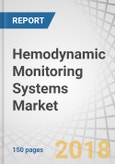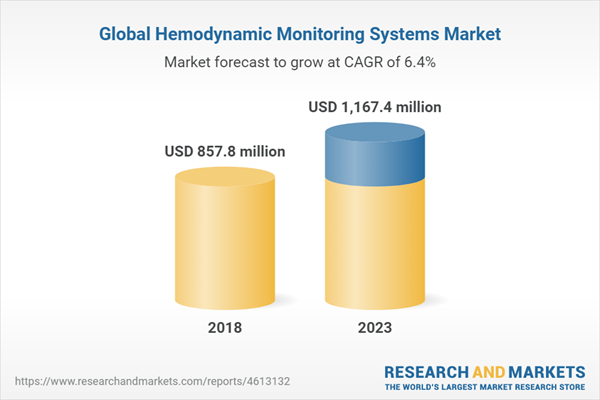The hemodynamic monitoring systems market is projected to grow at a CAGR of 6.4% during the forecast period.
The global hemodynamic monitoring systems market is expected to reach USD 1,167.4 million by 2023 from USD 857.8 million in 2018, at a CAGR of 6.4% during the forecast period. Technological advancements in hemodynamic monitoring systems, increasing research into hemodynamic monitoring systems, influx of VC funding, rising prevalence of cardiovascular diseases & diabetes, and government focus on critical care infrastructure & services are expected to drive the growth of the hemodynamic monitoring systems market. However, the risk associated with invasive hemodynamic monitoring, such as sepsis, bleeding, hemorrhage, thrombosis, air embolism, and pulmonary capillary necrosis is expected to restrain the growth of this market to a certain extent.
By product, the monitors segment is expected to grow at the highest rate during the forecast period.
Based on product, the global hemodynamic monitoring systems market is segmented into two broad categories: monitors and disposables. The monitors segment is expected to grow at the highest CAGR during the forecast period. This can be attributed to the increasing prevalence of CVDs; technological advancements in monitoring systems; increasing funding by government authorities for improving patient-centered care, safety, and efficiency; and the ability of hemodynamic monitors to improve cath lab efficiency.
By type, the noninvasive systems segment is expected to grow at the highest rate during the forecast period (2018–2023).
On the basis of type, the hemodynamic monitoring systems market is segmented into invasive, minimally invasive, and noninvasive systems. The noninvasive hemodynamic monitoring systems segment is expected to grow at the highest CAGR during the forecast owing to the benefits it offers such as reduced staffing costs, treatment expenses, and hospital stay. Furthermore, the rising incidence of respiratory disorders; fewer complications of noninvasive hemodynamic monitoring compared to invasive methods, enhanced portability & precision, and ease of use are additional factors driving the growth of this market segment.
By end user, the clinics and ambulatory care centers segment is expected to grow at the highest rate during the forecast period.
On the basis of end user, the global hemodynamic monitoring systems market is segmented into hospitals, clinics and ambulatory care centers (ACCs), and home care settings. The clinics and ACCs segment is expected to register the highest CAGR during the forecast period due to the growing number of ambulatory care centers globally, improving reimbursements for ACCs, growing number of patients visiting clinics & ACCs, and increasing number of initiatives by governments.
The Asia Pacific hemodynamic monitoring systems market is expected to grow at the highest CAGR during the forecast period.
Asia Pacific is expected to witness the highest growth from 2018 to 2023. This high growth rate is attributed to Japan’s growing healthcare industry; extensive government reimbursement coverage for critical cardiac procedures; improving healthcare infrastructure in India and China; high diabetes prevalence in Vietnam, Singapore, Malaysia, China, and India; and government initiatives in Australia and Singapore.
Break of primary participants was as mentioned below:
- By Company Type – Tier 1–55%, Tier 2–25% and Tier 3–20%
- By Designation – C-level–43%, Director Level–32%, Others–25%
- By Region – Europe–38%, North America–23%, Asia Pacific–29%, RoW–10%
Research Coverage:
The report analyzes the hemodynamic monitoring systems market and aims at estimating the market size and future growth potential of this market based on various segments such as product, type, end user, and region. The report also includes competitive analysis of the key players in this market along with their company profiles, product offerings, recent developments, and key market strategies.
Reasons to Buy the Report
The report can help established firms as well as new entrants/smaller firms to gauge the pulse of the market, which in turn would help them garner a greater share. Firms purchasing the report could use one or any combination of the below mentioned five strategies.
This report provides insights into the following pointers:
- Market Penetration: Comprehensive information on the product portfolios of the top players in the hemodynamic monitoring systems market. The report analyzes the market based on product, type, end user, and region
- Product Development/Innovation: Detailed insights on upcoming technologies, research and development activities, and product launches in the hemodynamic monitoring systems market
- Market Development: Comprehensive information about lucrative emerging markets. The report analyzes the markets for various hemodynamic monitoring systems across regions
- Market Diversification: Exhaustive information about products, untapped regions, recent developments, and investments in the market
- Competitive Assessment: In-depth assessment of market shares, strategies, products, distribution networks, and manufacturing capabilities of the leading players in the market
Table of Contents
Companies Mentioned
- Edwards Lifesciences Corporation
- Pulsion Medical Systems Se (Part of the Maquet Getinge Group)
- Lidco Group
- Deltex Medical Group PLC
- ICU Medical
- Cnsystems Medizintechnik GmbH
- Caretaker Medical
- Osypka Medical GmbH
- Cheetah Medical
- NI Medical
- Uscom
Table Information
| Report Attribute | Details |
|---|---|
| No. of Pages | 150 |
| Published | August 2018 |
| Forecast Period | 2018 - 2023 |
| Estimated Market Value ( USD | $ 857.8 million |
| Forecasted Market Value ( USD | $ 1167.4 million |
| Compound Annual Growth Rate | 6.4% |
| Regions Covered | Global |
| No. of Companies Mentioned | 11 |









